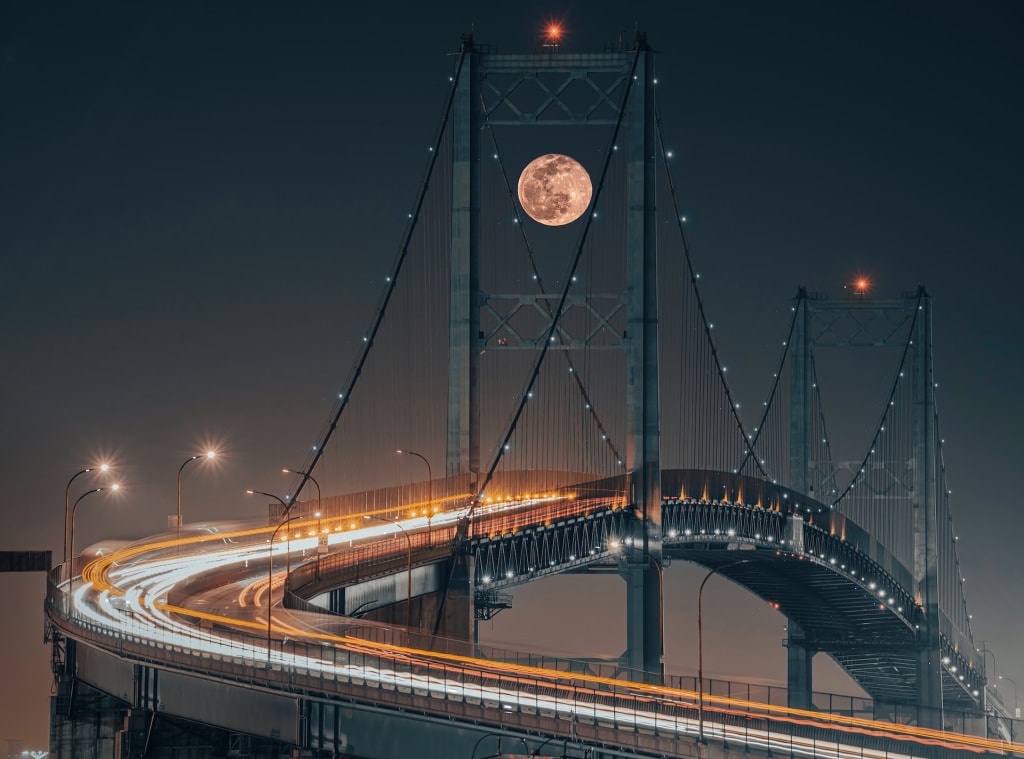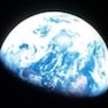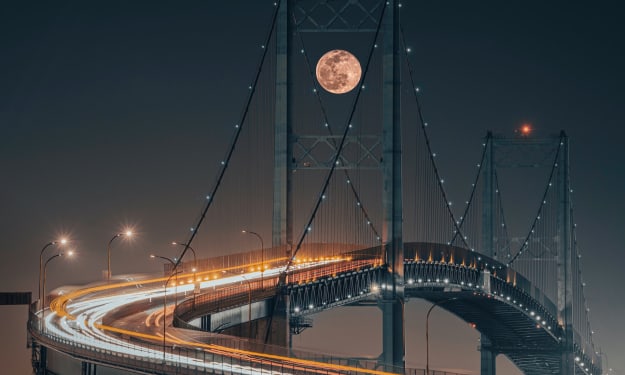Bridge To The Moon: The Lunar Tour
Chapter Eight: The Lunar Tour

(In which our intrepid traveller and friends are acquainted with many of the wonders of the moon.)
Great-great-great-great-great-great-granddad: After breakfast the next day we started our six week tour of the Moon. It sounds like a long tour, but when you consider that it’s a tour of an entire heavenly body, it’s not that long really. There was still plenty that we didn’t see!
We travelled by train-bus along magnetic-levitation railways most of the time. Occasionally we went by road, and there were a few times when we flew by lunar shuttle rocket. Sometimes we were even catapulted from one spot to another over craters or rimae, (which are long, narrow channels in the surface of the Moon). Because there’s pretty well no atmosphere to speak of on the Moon, there was no wind to blow us off course of the capture nets. However our luggage would go by rail or road - the long way around, and some people opted to go the long way round, not quite trusting the catapult transport, although it never worried me. (By the way, you’ll never see a plane or helicopter on the Moon - unless perhaps if it’s under a city’s or town’s enclosure, using its air for lift.)
We went to many lunar cities, towns, villages, settlements, all over the Moon. There were probably never more than five minutes spent travelling away from human habitation of some type, even if just a farmhouse, when we were properly on the move. Part of the reason for this is the speeds we travelled at, but mainly it’s because of the extent of settlement of the Moon at that time, (which although extensive, was actually quite sparse settlement compared to today).
Of course all developments were under airtight enclosures which only let a little infra-red, and no ultra-violet light in, and no air out, if they were more than a few buildings together. Most of these places only had lighting that shone down to the ground, not up into the sky, so as not to cause too much light pollution of the starry sky at night.
Sometimes when we arrived somewhere, there would be a special reception prepared for us, according to the customs of the locals’ culture. You might think there would be just one Moon culture, but when you consider all the parts of the worlds where the Moon people had come from, there was quite a lot of difference between these receptions. Sometimes the peoples’ faces would be quite distinctive, sometimes they would wear traditional clothes of their people, usually the food would be different in some small way, (if not in a very big way), and there was often different music as well. Sometimes the proceedings would be more formal, sometimes more casual, sometimes there would be no proceedings at all, just an invitation to eat, drink, talk, perhaps sing and dance, and generally make ourselves at home. Some of these receptions had one distinct culture, and some were fusions of several, since they had people from sometimes vastly different cultures who had come together.
We went to a number of the Moon’s largest metropolises - cities of tens of millions of Moonites, largely concentrated in skyscrapers of hundreds of storeys, and often arranged in intricate patterns when seen from above, looking like starfish or spider webs or multi-armed creatures, with hubs at many points all through them. We would often get whole or half days off in these cities to explore them for ourselves, and some of my friends and I would travel by subway, or overland train, or raised trains - whichever way, usually vacuum tube trains or gravity-vacuum trains - or in vehicles that operated like some fair ground rides on Earth, (only on a much, much larger scale), that you would enter, then get swung high up in the sky, only to be placed gently down on the ground several kilometres away.
Sometimes on a day or half day off we would go to a concert, or play, or movie, or virtual reality, or augmented reality, or some other entertainment. Sometimes we, or I, would just take time out, and veg out or sleep. Of course there were many occasions to shop for souvenirs, or whatever you wanted to buy.
There were a few times when I went to a religious house, either in quiet contemplation on my own or for a religious ceremony - sometimes as part of the tour, and sometimes just out of my own interest. I would use these moments, and other times, to quietly say thanks to God for letting me experience the wonders I was experiencing, and the people I was blessed to experience them with.
The tour usually took us to various museums and art galleries, and a school or university or institute or hospital, (where we heard about space medicine), or two; in big cities, and sometimes in smaller places as well. Sometimes there were two or more options for what to do, and various ones of us would do some things, and others would do others, according to our interests, or moods, or the influences of friends.
We also saw lots of monuments; parks and gardens; zoos; a wildlife park - it’s funny seeing animals moving in low gravity; farms; industry; mines; a military installation or two - one of which was involved in the Moon War; some festivals; fetes; parades - the list goes on and on.
Perhaps the most poignant artificial things we saw on the Moon were artefacts of the Apollo missions, that saw the first people, (that we know of), walking on the Moon. We saw preserved footprints where various Apollo missions went, an Apollo lunar rover, and some of the flags the astronauts left behind - their tops and sides always straight and stiff on their poles and wires, nevermore waving as if in wind, since the time the departing lunar modules blasted them with their ejected gas, (and caused the Apollo 11 flag to fall over), as they ascended, taking the astronauts back to the command modules, in which they returned to Earth: something we Moon tourists could do with much less planning and expense, and more luxuriously, on the Moon train.
But the landscape of the Moon may have been more poignant than the Apollo artefacts - I’m not sure, I find it hard to compare them. Rocks; mountains; valleys; plains (called oceanus, maria, lacus, sinus, paludes - all latin words for formations of fanciful water on ancient Moon maps); Reiner Gamma (an area on the Moon that has a high albedo, or is unusually bright); dorsa (wrinkly ridges); rimae (those long, narrow channels mentioned previously); rupes (escarpments); caves (generally thought to be ancient lava tubes - apart of course from the modern, artificial caves); and of course craters - lots and lots of craters. And all of these features competing for space with the aforementioned cities, towns, villages, settlements, farms, etc. Some of these natural wonders were in specially set-aside lunar parks, and some were not - and at risk of development.
Some of the craters had been turned into water storages, overtopped with see-through, temperature-controlled enclosures - just like the ones over cities and towns - to guard against evaporation into space, or freezing. Some of these were used for water consumption, some as marine habitats, and some were used for recreation - swimming, boating, fishing, snorkelling, waterskiing, even some with wave machines for surfing. Some of us, myself included, went fishing, swimming, waterskiing and surfing on the Moon.
We weren’t just among plains and craters while on the Moon, we were often in mountainous areas, and we went skiing once on a ski-slope with artificial snow, under one of the huge, invisible ceilings over a city, in lofty, lunar heights. As I recall, part of this city was underground - carved into the side of a mountain. There were streets in a cavern with beautiful, coloured lighting, and lots of colour in the buildings, and on the walls, ceiling and floor of the cavern - colour from paint, colour from plants, and colour painted with light onto the walls of the cavern.
Among the less glamorous things we briefly visited on the Moon, were a cemetery and crematoria, a rubbish dump, and a sewerage works, (although these were options, and many of the people on the tour did other things instead). The Moonites, who tend to be a very environmentally-aware and efficient people, generally favoured a type of swift, high energy cremation of many deceased people at a time, with the ashes being scattered on the Moon’s surface - usually mixed with compost. (They would have individual funeral services previously, but leave the bodies to wait for the next cremation - which would generally not be attended by the mourners.) They used the same high energy incineration process with any rubbish they couldn’t recycle, (although they recycled something like 99.999999% of their rubbish). Sewerage was treated so effectively it was all recycled - either as potable water or compost - with no harmful substances remaining.
We visited the Lunar parliament and learned about the administration of the Moon. We were told about the Moon’s human history, from the first orbits of Earth rockets in the 1960s to the current time, with an emphasis on the Moon War and how it was quickly put down by the actions of the Moon people themselves, who were shocked that such a horrific thing should break out on their fragile rock and threaten their very existence, for the sake of the aggrandisement of a power-lusting few.
I think my favourite time on the Moon was when we went for a short time, east or west, (I don’t remember which now), into the night darkness, in an area which was largely undeveloped, to go stargazing. We looked back as we travelled, and watched, first the Earth set, then the sun set - and suddenly it seemed as if the heavens were drowned in millions of tiny fairy-lights, as the stars miraculously appeared! (Although they really scientifically appeared - but it seemed miraculous!)
When we’d gone some way further, we stopped and got out of the bus, in our temperature-controlled, relatively thin, but immensely strong, life-preserving spacesuits, speaking to each other, and some of us to friends and relatives back on Earth, while experiencing for a short time the reality of the Moon night. We couldn’t see anything on the Moon’s surface unless we shone a light onto it. We could only see each other, the bus, and the brilliant stars - which showed us where the sky ended and the Moon began, as a line of little lights which outlined the lunar horizon in 360 degrees. Then, after a while, we got back in the bus and headed back the way we’d come, and saw first the sun rise, (as the stars vanished again), then the Earth rise, back in the two-Earth-week-long Moon day, and kind of felt in a way that we’d returned to civilisation.
When we went round to the so-called “dark” side of the Moon, (really the far side of the Moon from an Earth perspective), that was when we seemed to be really disconnected from the Earth, even though we could still talk to people on Earth, with seemingly no more delay than when we talked to them from the near side. We saw the Earth set around the horizon as we headed west. The sun was still our constant companion, but we wouldn’t see our home planet again for the next two weeks. I guess we got used to this after a while, but sometimes I would think it was odd not to see the Earth in the sky, and I’d feel more homesick than usual.
Two weeks later we came back round to the near side of the Moon, and saw the Earth rise in the west. It was very, very good to see our beautiful home again, even if from about 384,000 kilometres away! And two weeks after that our package tour of the Moon came to and end, and it was time to catch the train back to Earth!
Next time:
Chapter Nine The Return
(or read the whole story here: https://vocal.media/fiction/bridge-to-the-moon)
About the Creator
Nicholas Edward Earthling
Hello fellow earthlings. I am one of you! I hope you're happy about that.
I'm an Australian retiree who wants to write as a hobby, and perhaps have some critical and commercial success. However, I do value my privacy so won't be oversharing.
Enjoyed the story? Support the Creator.
Subscribe for free to receive all their stories in your feed. You could also pledge your support or give them a one-off tip, letting them know you appreciate their work.






Comments
There are no comments for this story
Be the first to respond and start the conversation.